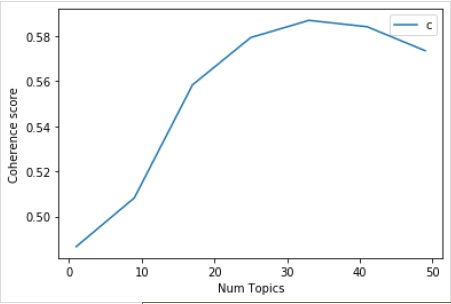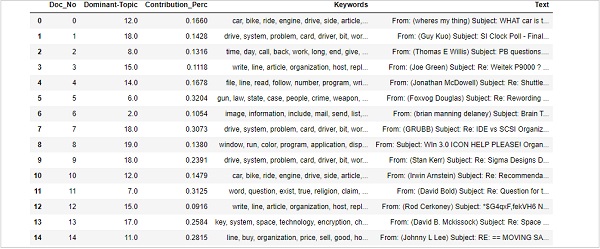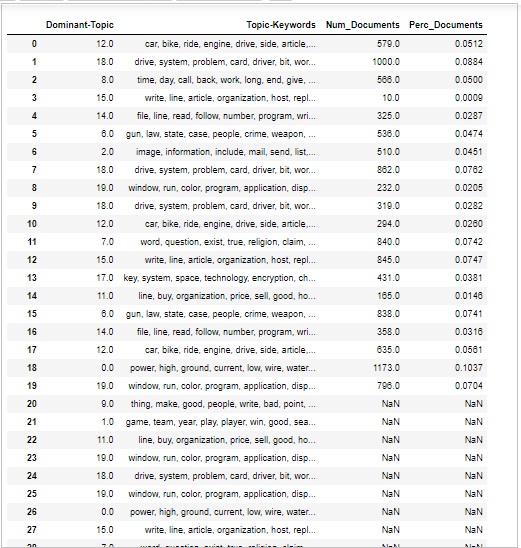Gensim - दस्तावेज़ और LDA मॉडल
इस अध्याय में गेंसिम में दस्तावेजों और एलडीए मॉडल पर चर्चा की गई है।
एलडीए के लिए विषयों की इष्टतम संख्या ढूँढना
हम विभिन्न मूल्यों वाले विभिन्न एलडीए मॉडल बनाकर एलडीए के लिए विषयों की इष्टतम संख्या पा सकते हैं। उन एलडीए में से हम सबसे अधिक सुसंगत मूल्य रख सकते हैं।
नाम के समारोह के बाद coherence_values_computation()कई एलडीए मॉडल को प्रशिक्षित करेंगे। यह मॉडल और साथ ही उनके सुसंगत स्कोर को भी प्रदान करेगा -
def coherence_values_computation(dictionary, corpus, texts, limit, start=2, step=3):
coherence_values = []
model_list = []
for num_topics in range(start, limit, step):
model = gensim.models.wrappers.LdaMallet(
mallet_path, corpus=corpus, num_topics=num_topics, id2word=id2word
)
model_list.append(model)
coherencemodel = CoherenceModel(
model=model, texts=texts, dictionary=dictionary, coherence='c_v'
)
coherence_values.append(coherencemodel.get_coherence())
return model_list, coherence_valuesअब निम्नलिखित कोड की मदद से, हम उन विषयों की इष्टतम संख्या प्राप्त कर सकते हैं, जिन्हें हम ग्राफ़ की सहायता से भी दिखा सकते हैं -
model_list, coherence_values = coherence_values_computation (
dictionary=id2word, corpus=corpus, texts=data_lemmatized,
start=1, limit=50, step=8
)
limit=50; start=1; step=8;
x = range(start, limit, step)
plt.plot(x, coherence_values)
plt.xlabel("Num Topics")
plt.ylabel("Coherence score")
plt.legend(("coherence_values"), loc='best')
plt.show()उत्पादन

इसके बाद, हम विभिन्न विषयों के लिए सुसंगत मूल्यों को भी निम्नानुसार मुद्रित कर सकते हैं -
for m, cv in zip(x, coherence_values):
print("Num Topics =", m, " is having Coherence Value of", round(cv, 4))उत्पादन
Num Topics = 1 is having Coherence Value of 0.4866
Num Topics = 9 is having Coherence Value of 0.5083
Num Topics = 17 is having Coherence Value of 0.5584
Num Topics = 25 is having Coherence Value of 0.5793
Num Topics = 33 is having Coherence Value of 0.587
Num Topics = 41 is having Coherence Value of 0.5842
Num Topics = 49 is having Coherence Value of 0.5735अब, सवाल उठता है कि हमें अब कौन सा मॉडल चुनना चाहिए? अच्छी प्रथाओं में से एक मॉडल को चुनना है, जो कि चापलूसी करने से पहले उच्चतम सुसंगतता दे रही है। इसलिए, हम उन 25 विषयों के साथ मॉडल का चयन करेंगे जो उपरोक्त सूची में 4 वें स्थान पर हैं।
optimal_model = model_list[3]
model_topics = optimal_model.show_topics(formatted=False)
pprint(optimal_model.print_topics(num_words=10))
[
(0,
'0.018*"power" + 0.011*"high" + 0.010*"ground" + 0.009*"current" + '
'0.008*"low" + 0.008*"wire" + 0.007*"water" + 0.007*"work" + 0.007*"design" '
'+ 0.007*"light"'),
(1,
'0.036*"game" + 0.029*"team" + 0.029*"year" + 0.028*"play" + 0.020*"player" '
'+ 0.019*"win" + 0.018*"good" + 0.013*"season" + 0.012*"run" + 0.011*"hit"'),
(2,
'0.020*"image" + 0.019*"information" + 0.017*"include" + 0.017*"mail" + '
'0.016*"send" + 0.015*"list" + 0.013*"post" + 0.012*"address" + '
'0.012*"internet" + 0.012*"system"'),
(3,
'0.986*"ax" + 0.002*"_" + 0.001*"tm" + 0.000*"part" + 0.000*"biz" + '
'0.000*"mb" + 0.000*"mbs" + 0.000*"pne" + 0.000*"end" + 0.000*"di"'),
(4,
'0.020*"make" + 0.014*"work" + 0.013*"money" + 0.013*"year" + 0.012*"people" '
'+ 0.011*"job" + 0.010*"group" + 0.009*"government" + 0.008*"support" + '
'0.008*"question"'),
(5,
'0.011*"study" + 0.011*"drug" + 0.009*"science" + 0.008*"food" + '
'0.008*"problem" + 0.008*"result" + 0.008*"effect" + 0.007*"doctor" + '
'0.007*"research" + 0.007*"patient"'),
(6,
'0.024*"gun" + 0.024*"law" + 0.019*"state" + 0.015*"case" + 0.013*"people" + '
'0.010*"crime" + 0.010*"weapon" + 0.010*"person" + 0.008*"firearm" + '
'0.008*"police"'),
(7,
'0.012*"word" + 0.011*"question" + 0.011*"exist" + 0.011*"true" + '
'0.010*"religion" + 0.010*"claim" + 0.008*"argument" + 0.008*"truth" + '
'0.008*"life" + 0.008*"faith"'),
(8,
'0.077*"time" + 0.029*"day" + 0.029*"call" + 0.025*"back" + 0.021*"work" + '
'0.019*"long" + 0.015*"end" + 0.015*"give" + 0.014*"year" + 0.014*"week"'),
(9,
'0.048*"thing" + 0.041*"make" + 0.038*"good" + 0.037*"people" + '
'0.028*"write" + 0.019*"bad" + 0.019*"point" + 0.018*"read" + 0.018*"post" + '
'0.016*"idea"'),
(10,
'0.022*"book" + 0.020*"_" + 0.013*"man" + 0.012*"people" + 0.011*"write" + '
'0.011*"find" + 0.010*"history" + 0.010*"armenian" + 0.009*"turkish" + '
'0.009*"number"'),
(11,
'0.064*"line" + 0.030*"buy" + 0.028*"organization" + 0.025*"price" + '
'0.025*"sell" + 0.023*"good" + 0.021*"host" + 0.018*"sale" + 0.017*"mail" + '
'0.016*"cost"'),
(12,
'0.041*"car" + 0.015*"bike" + 0.011*"ride" + 0.010*"engine" + 0.009*"drive" '
'+ 0.008*"side" + 0.008*"article" + 0.007*"turn" + 0.007*"front" + '
'0.007*"speed"'),
(13,
'0.018*"people" + 0.011*"attack" + 0.011*"state" + 0.011*"israeli" + '
'0.010*"war" + 0.010*"country" + 0.010*"government" + 0.009*"live" + '
'0.009*"give" + 0.009*"land"'),
(14,
'0.037*"file" + 0.026*"line" + 0.021*"read" + 0.019*"follow" + '
'0.018*"number" + 0.015*"program" + 0.014*"write" + 0.012*"entry" + '
'0.012*"give" + 0.011*"check"'),
(15,
'0.196*"write" + 0.172*"line" + 0.165*"article" + 0.117*"organization" + '
'0.086*"host" + 0.030*"reply" + 0.010*"university" + 0.008*"hear" + '
'0.007*"post" + 0.007*"news"'),
(16,
'0.021*"people" + 0.014*"happen" + 0.014*"child" + 0.012*"kill" + '
'0.011*"start" + 0.011*"live" + 0.010*"fire" + 0.010*"leave" + 0.009*"hear" '
'+ 0.009*"home"'),
(17,
'0.038*"key" + 0.018*"system" + 0.015*"space" + 0.015*"technology" + '
'0.014*"encryption" + 0.010*"chip" + 0.010*"bit" + 0.009*"launch" + '
'0.009*"public" + 0.009*"government"'),
(18,
'0.035*"drive" + 0.031*"system" + 0.027*"problem" + 0.027*"card" + '
'0.020*"driver" + 0.017*"bit" + 0.017*"work" + 0.016*"disk" + '
'0.014*"monitor" + 0.014*"machine"'),
(19,
'0.031*"window" + 0.020*"run" + 0.018*"color" + 0.018*"program" + '
'0.017*"application" + 0.016*"display" + 0.015*"set" + 0.015*"version" + '
'0.012*"screen" + 0.012*"problem"')
]वाक्यों में प्रमुख विषयों का पता लगाना
वाक्यों में प्रमुख विषयों को खोजना विषय मॉडलिंग के सबसे उपयोगी व्यावहारिक अनुप्रयोगों में से एक है। यह निर्धारित करता है कि दिए गए दस्तावेज़ किस विषय के बारे में हैं। यहां, हम उस विषय संख्या को प्राप्त करेंगे जिसका उस विशेष दस्तावेज़ में सबसे अधिक प्रतिशत योगदान है। किसी तालिका में जानकारी एकत्र करने के लिए, हम एक फ़ंक्शन का नाम देंगेdominant_topics() -
def dominant_topics(ldamodel=lda_model, corpus=corpus, texts=data):
sent_topics_df = pd.DataFrame()आगे, हमें हर दस्तावेज में मुख्य विषय मिलेंगे -
for i, row in enumerate(ldamodel[corpus]):
row = sorted(row, key=lambda x: (x[1]), reverse=True)इसके बाद, हम प्रत्येक दस्तावेज के लिए डोमिनेंट विषय, Perc योगदान और कीवर्ड प्राप्त करेंगे -
for j, (topic_num, prop_topic) in enumerate(row):
if j == 0: # => dominant topic
wp = ldamodel.show_topic(topic_num)
topic_keywords = ", ".join([word for word, prop in wp])
sent_topics_df = sent_topics_df.append(
pd.Series([int(topic_num), round(prop_topic,4), topic_keywords]), ignore_index=True
)
else:
break
sent_topics_df.columns = ['Dominant_Topic', 'Perc_Contribution', 'Topic_Keywords']निम्नलिखित कोड की मदद से, हम मूल पाठ को आउटपुट के अंत में जोड़ देंगे -
contents = pd.Series(texts)
sent_topics_df = pd.concat([sent_topics_df, contents], axis=1)
return(sent_topics_df)
df_topic_sents_keywords = dominant_topics(
ldamodel=optimal_model, corpus=corpus, texts=data
)अब, वाक्यों में विषयों का प्रारूपण निम्न प्रकार से करें -
df_dominant_topic = df_topic_sents_keywords.reset_index()
df_dominant_topic.columns = [
'Document_No', 'Dominant_Topic', 'Topic_Perc_Contrib', 'Keywords', 'Text'
]अंत में, हम प्रमुख विषयों को निम्नानुसार दिखा सकते हैं -
df_dominant_topic.head(15)
सबसे अधिक प्रतिनिधि दस्तावेज़ ढूँढना
विषय के बारे में अधिक समझने के लिए, हम दस्तावेजों को भी पा सकते हैं, किसी दिए गए विषय ने सबसे अधिक योगदान दिया है। हम उस विशेष दस्तावेज़ (दों) को पढ़कर उस विषय का अनुमान लगा सकते हैं।
sent_topics_sorteddf_mallet = pd.DataFrame()
sent_topics_outdf_grpd = df_topic_sents_keywords.groupby('Dominant_Topic')
for i, grp in sent_topics_outdf_grpd:
sent_topics_sorteddf_mallet = pd.concat([sent_topics_sorteddf_mallet,
grp.sort_values(['Perc_Contribution'], ascending=[0]).head(1)], axis=0)
sent_topics_sorteddf_mallet.reset_index(drop=True, inplace=True)
sent_topics_sorteddf_mallet.columns = [
'Topic_Number', "Contribution_Perc", "Keywords", "Text"
]
sent_topics_sorteddf_mallet.head()उत्पादन

मात्रा और विषयों का वितरण
कभी-कभी हम यह भी जज करना चाहते हैं कि दस्तावेजों में विषय पर व्यापक रूप से चर्चा कैसे की जाए। इसके लिए हमें दस्तावेज़ों में विषयों के आयतन और वितरण को समझना होगा।
सबसे पहले प्रत्येक विषय के लिए दस्तावेजों की संख्या की गणना करें -
topic_counts = df_topic_sents_keywords['Dominant_Topic'].value_counts()अगला, प्रत्येक विषय के लिए दस्तावेजों के प्रतिशत की गणना निम्नानुसार है -;
topic_contribution = round(topic_counts/topic_counts.sum(), 4)अब विषय संख्या और खोजशब्द इस प्रकार है -
topic_num_keywords = df_topic_sents_keywords[['Dominant_Topic', 'Topic_Keywords']]अब, बाद में संक्षिप्त रूप में संक्षिप्त करें -
df_dominant_topics = pd.concat(
[topic_num_keywords, topic_counts, topic_contribution], axis=1
)अगला, हम कॉलम के नाम इस प्रकार बदलेंगे -
df_dominant_topics.columns = [
'Dominant-Topic', 'Topic-Keywords', 'Num_Documents', 'Perc_Documents'
]
df_dominant_topicsउत्पादन
